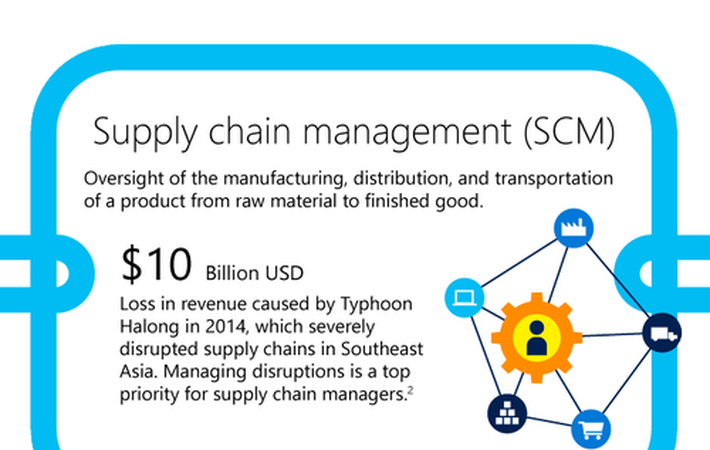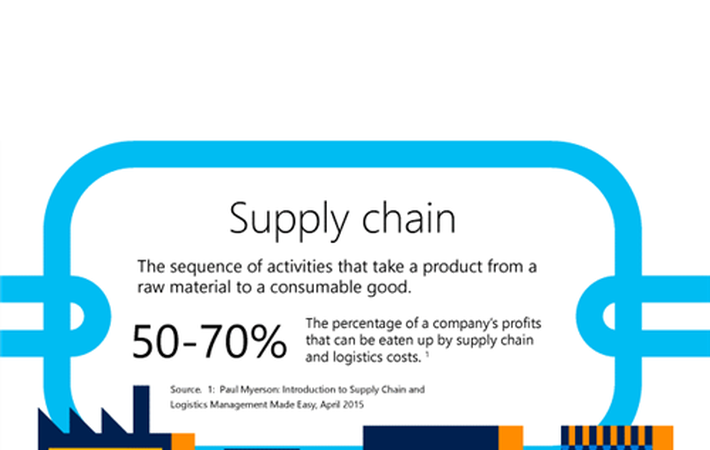
Published on 11/18/2016 | Strategy
Maintaining a holistic view of your supply chain activities is essential for efficiency. No matter what kind of business you run, it should run like clockwork. And to do so, you need to be able to examine your business—every inch of it—in real time. To have supply chain control, you need to know what’s going on at every stage, at all times.
Traditionally, enterprise resource planning (ERP) solution will provide organizations the control of your supply chain you need for more efficient people and processes, a better handle on costs, happier customers and, ultimately, greater profits. Data from disparate systems and sensor-enabled products and control points along the entire extended supply chain is aggregated and rolled up into KPIs, scorecards and dashboards to deliver managers and workers actionable role-based information in real time, allowing them to monitor events and manage performance. Secure, reliable yet flexible technologies integrate multi-enterprise collaborative workflows for all partners, including transactional supply chain portals, which significantly streamline operations and make it possible for everyone to connect and quickly resolve issues when they occur. Microsoft technology also delivers the foundation for easier integration with corporate IT infrastructure and existing enterprise and operations systems—either Microsoft-based or other technologies— and provide users with familiar and easy-to-use interfaces.
Reduce, reuse, recycle. It’s good for the environment and good for your supply chain. The traditional approach to supply chain management is a linear progression from producer to consumer, but times they are a changin’. As sustainable manufacturing becomes more important for both environmental impact and profitability, the traditional supply chain model is beginning to shift. The newer, more sustainable approach adopts a “circular” or “closed-loop” model of production, distribution, and consumption. Meaning, discarded or returned products are continuously fed back into the supply chain to be repurposed or recycled. Another way to innovate on your organization Supply Chain is through IoT.
Executives across industries know they need to understand where the Internet of Things will affect their industry, where value comes from in their industry, where their companies can enter and play, and what capabilities they need to win. But many tell us they are finding it difficult to get a foothold and develop a strategy. Many are already investing significantly, but few have a clear roadmap. Customers are very interested, but complete solutions are still in their infancy.
Before technology executives can form their strategies, they need to see that the Internet of Things is not one market but a set of overlapping markets with strong connections to the data center and analytics. Understanding where battlegrounds are emerging, how platform dynamics will shape competition and profitability, and what barriers exist to adoption (for example, security and interoperability) will help companies determine where to invest and what capabilities are required to win.
Learn more about supply chain management with this infographic
The Internet of Things (IoT) is changing business as we know it. Defined as the place where the digital world meets the physical, it’s working to create extended enterprises that reach beyond the traditional supply chain paradigm. Supply chains used to be severed once the product reached the consumer, but with the Internet of Things, the chain now continues to another link.

So, what is the Internet of Things? Why is it important and what does it do for us? Specifically, what can it do for supply chain management?
The Internet of Things is a catchall name for any and all physical products, devices, appliances, etc. that are embedded with some sort of digital component, like sensors, software, or internet connectivity. Like a refrigerator that’s Wi-Fi enabled. Or a device or program that allows you to close your garage door, turn off lights, and enable your security system, directly from your smartphone.
One study by Gartner estimates that by 2020, over 20 billion “things” will be digitally connected. That’s close to 3 “things” for every person currently on the planet.
As products become smarter, so do the supply chains that deliver these products to the consumer. Objects and goods that deliver information contribute to a more holistic, 360-degree data visualization of a supply chain.
For example, Microsoft customer WASH Multifamily Laundry Services has harnessed the power of connected devices to provide real-time data on the company’s washers and dryers. With over half a million washers and dryers in 75,000 locations, the ability to warehouse and gain insight on the data the machines provide is invaluable. WASH utilizes sensors, barcodes, smartphones, and other devices to gather data relevant to service calls and repair issues. Being able to view this data promotes overall supply chain efficiencies for WASH.
Manufacturing industries can benefit from IoT with a more connected and automated production line. Technologies like temperature gauges in factory facilities can optimize the perfect environment for the production of climate-sensitive goods.
Supply chain logistics can benefit from point-in-time data that will encourage shipping efficiencies. Product delivery delays can be avoided by using data to suggest the most efficient travel routes.
A more intelligent supply chain can enable greater efficiencies and, therefore, greater returns on investment. Providing additional data on a product after its purchase contributes to its overall value. Collecting data about the functionality of a product while a consumer is using it is invaluable. With this knowledge, you’re able to improve the next generation of your product with feedback provided directly by your users.
Supply chain management and the Internet of Things might just be a match that can drive tremendous value to your business. With devices and connectivity to enable smarter production, more efficient logistics, and products smart enough to transmit data, the Internet of Things is facilitating smarter, more agile, and more connected supply chains.
This article was originally posted on LinkedIn.